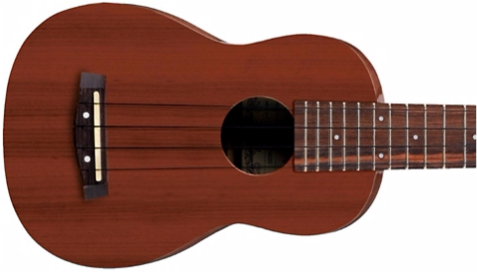Types of Strings
Let's face it: most of our programs are not swimming in funding. We cringe every time we have to go and ask for any kind of money for even the basics to support our programs. On the other hand, if we are starting a ukulele program in our school, we want the instruments to sound as good as they can, so students do not get the impression that these are toys!
When you buy your first set of classroom ukuleles (what a day that is!), they will of course come with strings. In lower-cost ukuleles, however, these strings can be pretty bad. Often, they will arrive with a black nylon-type of string on them (as you see in the picture below). If your ukulele shows up with strings like this, you probably want to change them immediately. It will improve the sound of the instrument immediately. Take a listen below:
When you buy your first set of classroom ukuleles (what a day that is!), they will of course come with strings. In lower-cost ukuleles, however, these strings can be pretty bad. Often, they will arrive with a black nylon-type of string on them (as you see in the picture below). If your ukulele shows up with strings like this, you probably want to change them immediately. It will improve the sound of the instrument immediately. Take a listen below:
But what types are there, and is there a way to do it without investing even more? The most common suggestion you will come across is that putting a set of Aquila Nylgut strings will immediately improve the sound of a cheap ukulele. This is absolutely true, and many cheap ukuleles now come pre-strung with Aquilas. However, even at bulk school discounts, Aquilas will run you just under $6 per set. If you have a set of 30 ukuleles, that can run your costs up pretty quickly!
My suggestion may come across as unorthodox, but will save you a LOT of money if you are replacing your classroom instrument strings - Fishing Line. Yup...you read that right; stick with me. Once you try them, you might find yourself hooked. (Couldn't resist!)
My suggestion may come across as unorthodox, but will save you a LOT of money if you are replacing your classroom instrument strings - Fishing Line. Yup...you read that right; stick with me. Once you try them, you might find yourself hooked. (Couldn't resist!)
Cost Comparison of Strings
(The basic types of ukulele strings you'll find on the market are Nylon, Fluorocarbon, and Nylgut. (Nylgut is brand-specific to a company called Aquila.) There are differences in the sound of each, but for the most part, which is "best" will come down to tonal preferences and the particular instrument that you put them on.
|
Fluorocarbon, however, is exactly the same material used in monofilament fishing line. If you use the correct weight of line, it's possible to string a ukulele with fishing line that will end up costing a great deal less than purchasing individual sets of strings. Take a listen to an example of a ukulele strung with Aquila Nylgut versus Seaguar Fishing Line:
|
|
Does it change the sound? Absolutely! Is it better? Depends on the instrument. On the Peavey in the example above, it does not have the same bass response with the fishing line as it does with the Nylgut. Either way, it's a decent sound, and still better than those nasty black strings on so many of these instruments! The cost difference, however, is huge. Check out the chart below.
It's common to see fishing line of required weight sold in 25 yard spools. If you have concert-sized ukuleles, you should be able to string about 45 ukuleles, depending on how much slack you wind on the tuners. Seaguar is a premium-brand fishing line that many ukulele players hold up as being the best-sounding for strings. Hi-Seas is a more common brand that I've tried that works well, too. Here's the difference in cost, assuming 45 sets of strings:
It's common to see fishing line of required weight sold in 25 yard spools. If you have concert-sized ukuleles, you should be able to string about 45 ukuleles, depending on how much slack you wind on the tuners. Seaguar is a premium-brand fishing line that many ukulele players hold up as being the best-sounding for strings. Hi-Seas is a more common brand that I've tried that works well, too. Here's the difference in cost, assuming 45 sets of strings:
|
Line Weight Calculation (Concert Ukulele)
High-G (Re-entrant) Tuning g - 40 lb C - 80 lb e - 50 lb a - 30 lb |
Ukulele Strings
D'Addario Natural Nyltech (4.99 per set): $224.55 Aquila Nylgut (5.79 per set): $260.55 Martin M600 Fluorocarbon (4.49 per set): $202.05 Fishing Line Seaguar Blue Label Fluorocarbon (1.93 per set): $86.93 Hi-Seas Fluorocarbon (1.45 per set): $65.11 |
Besides the obvious cost difference in purchasing outright, there are likely to be parents, teachers and community members who already have extra fishing line, and would be willing to donate them to your program! What a great way to get the community involved in your program, and give them a sense of ownership in supporting you!
Want to hear the difference between all of them? Take a listen below. I've also included at the end an example of the Nylgut Low-G strings, in case you want to string your ukuleles using that tuning.
Want to hear the difference between all of them? Take a listen below. I've also included at the end an example of the Nylgut Low-G strings, in case you want to string your ukuleles using that tuning.

